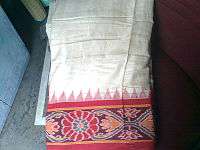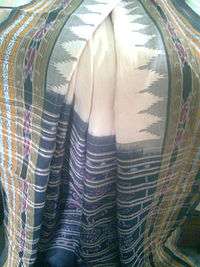Sambalpuri saree


Sambalpuri Saree (Odia: ସମ୍ବଲପୁରୀ ଶାଢ଼ି) is a traditional handwoven ikat or sari or saree (locally called sadhi) wherein the warp and the weft are tie-dyed before weaving. It is produced in the Bargarh, Sonepur, Sambalpur, Balangir district, Boudh District of Odisha. The saree is a traditional female garment in the Indian Subcontinent[1] consisting of a strip of unstitched cloth ranging from four to nine metres in length that is draped over the body in various styles.
Sambalpuri sarees are known for their incorporation of traditional motifs like shankha (shell), chakra (wheel), phula (flower), all of which have deep symbolism, but the highpoint of these sarees is the traditional craftsmanship of the 'Bandhakala', the Tie-dye art reflected in their intricate weaves, also known as Sambalpuri "Ikkat". In this technique, the threads are first tie-dyed and later woven into a fabric, with the entire process taking many weeks. These sarees first became popular outside the state when the late Prime Minister Indira Gandhi started wearing them. In the 1980s and 1990s they became popular across India.[2] To provide protection to the weavers practicing this art, the handloom silk sarees manufactured in Sambalpur and Berhampur (Berhampur Pattu) in Odisha were included in the Government of India’s Geographical Indications (GI) registry.[3][4]
The Sambalpuri saree

The Sambalpuri sari is made from fabric woven on a hand-loom and is popular throughout India.[5] Varieties of the Sambalpuri sari include Sonepuri, Pasapali, Bomkai, Barpali, and Bapta saris, which are in high demand. Most of them have been named after their places of origin and are popularly known as Pata. Paintings on Tussar saris depicting Mathura Vijay, Raslila and Ayodhya Vijay owe their origin to ‘Raghurajpur patta paintings’.

Fabric and design
Sambalpuri fabrics reflect an original style of craft known as Baandha. Traditionally, craftsmen created Baandhas with images of flora or fauna or with geometrical patterns. More recently, new types of Baandha depicting portrait, landscape and flower pods are being designed. Baandha fabric is created using a tie-dye technique. The yarns are tied according to the desired patterns to prevent absorption of dyes, and then dyed. The yarns or set of yarns so produced is called 'Baandha'. The unique feature of this form of designing is that the designs are reflected almost identically on both side of the fabric.Once the frabic is dyed it can never be belached in to other colour.[6] This versatile technique enables a craftsman to weave colourful designs, patterns and images into a fabric capable of inspiring a thought or conveying a message. Thus Baandha can be defined as "A length of systematically arranged yarn, dyed according to a preconceived design in such a manner so as to enable a weaver to portray the design when the yarn is converted to a fabric through the process of weaving". It is believed that this art migrated to Western Odisha along with the Bhulia community who fled Northern India in the year 1192 AD after the fall of the Chouhan empire at the hands of the Mughals. Since then and up to the year 1925 it flourished in Western Odisha in a limited number of designs and in vegetable colours and consisted mostly of saris used by the womenfolk of the Odisha. These saris were known as 'Bhulia-Kapta'. The demand was limited, distress sale was common and the craftsmen lived in penury.
Development
Today the Baandha fabric is popularly known by its geographical and cultural name Sambalpuri owing to the pioneering efforts of Sri Radhashyam Meher, who brought about a radical improvement in the skills of the craftsmen and the quality of the products. Other master craftsmen who contributed to the development of Sambalpuri textiles were Padmashree Kailash Chandra Meher, Padmashree Kunja Bihari Meher, Padmashree Chatrubhuja Meher and Padmashree Krutharth Acharya. Sambalpuri textiles today include furnishing materials, dress materials and sarees in silk, cotton and mercerised cotton in a variety of colours and many different designs. Baandha craftsmen are also masters of the 'extra warp' and 'extra weft' style of designing which can be seen in almost all forms of Baandha textiles. Radhashyam Meher also produced Khadi textiles using the Baandha art.[7]
In 1926, Radhashyam designed the first handloom to weave textiles of ninety inches width. This achievement made him the 'Parda agent' of the Government of Bihar for the production of furnishing materials. Later, after the formation of the state of Odisha, he became the 'Parda agent' of the government of Odisha. His dexterity in the Baandha art and his ability to motivate the weaving community in the region to improve their skills by providing the necessary training and incentives enabled the creation of new designs that received international fame and recognition.
Radhashyam Meher established his proprietary concern, named 'Utkal Parda Agency', at Sambalpur for the research, production and marketing of Sambalpuri textiles. Acknowledging Radhashyam Meher's unparalleled contribution to the growth and popularity of 'Baandha art', the Ministry of Textiles of the Government of India has sponsored textile exhibitions coinciding with his birth anniversary on November 20 and organised by the Director of Textiles of the Government of Odisha.
He also played an active role in the cooperative movement and organised the Meher Art Fabrics cooperative society Ltd and the Sambalpur Regional Cooperative Marketing Society Ltd. (RCMS) He was a member of the All India Handloom Board in the year 1953. Until his death he was always elected as the member of the Sambalpur Municipality.[8]
Industry
Roughly 16 km from the district headquarters of Sonepur, Sagarpali is a large village hosting around 500 bhulia (weaver) families. This is one of the largest weaving villages in Kosal, a bastion of the Sambalpuri sari. Other areas affluent with handloom weavers are Barpali, Tarbha, Bijepur, Patnagarh and Bargarh.
Important handloom clusters of Odisha
| Serial No. | Category of cluster | Name of district | Name of cluster | Number of clusters |
|---|---|---|---|---|
| 1 | A | Bargarh | Attabira, Bargarh, Bheden, Barpali, Bijepur, Padampur, Sohela, Bhatli | 8 |
| 2 | A | Subarnapur/Sonepur | Birmaharajpur, Sonepur, Ulunda, Binika | 4 |
| 3 | A | Boudh | Boudh | 1 |
| 4 | B | Balangir | Patnagarh, Agalpur, Bangamunda | 3 |
| 5 | B | Nuapada | Khariar (Sinapali) | 1 |
| 6 | B | Sambalpur | Rengali | 1 |
Important handloom centers of western Odisha and famous products
| Districts | Sambalpuri handloom product |
|---|---|
| Bargarh | bed cover, dress materials, cotton tie & dye saree, silk Sambalpuri saree, coarse cotton saree & others |
| Sonepur & Boudh | silk Bomkai saree, tie & dye cotton saree, furnishing & silk tie & dye saree |
| Kalahandi | Habaspuri saree, coarse cotton saree & others |
| Balangir | tie & dye cotton saree & furnishings, silk tie & dye saree, coarse cotton saree & others |
| Sundergarh & Sambalpur | coarse cotton saree & others |
Sambalpuri Bastralaya
Sambalpuri Bastralaya Handloom Cooperative Society Ltd., Bargarh. The pioneer handloom institution of the state was established at Bargarh in 1930 by the late Padmashree Krutharth Acharya. Subsequently it was recognized by the Odisha government in 1954. It is the largest primary handloom cooperative society in the state and country as well. Since its inception, it has been working as a production and marketing society by providing impute and marketing support regularly to its weaver members under a co-operative framework. This institution being a leading one in the state is widely known for its efficient commitment, for the uplifting of the scheduled caste and scheduled tribes and economically backward classes of society, including women.[10]
Odisha Saree Store
Odisha Saree Store started on the year 2013 with aim to promote handloom Sambalpuri, ikat, khandua, kotpad, siminoi sarees because this art is dying very fast. Their team met weavers all around Odisha and listen to their issues and problems. Many of the weaver leaving odisha and travelling far places to work for their family. This Organization helping them and need all your support to do so.[11]
Other Sambalpuri handloom products
Besides saree one can get Sambalpuri curtains, bedsheets, dewan sets, sofa covers, towels, dress materials, Sambalpuri Salwar Kamiz, Kurti, Dhila etc.
Further reading
- The Orissan art of weaving, by Kesabachandra Mehera, Publisher: Keshab Chandra Meher, 1995.
- Indian ikat textiles, V & A Museum Indian Art Series. by Rosemary Crill, Victoria and Albert Museum. V & A Publications, 1998. ISBN 1851772421.
References
- ↑ Alkazi, Roshan (1983) "Ancient Indian costume", Art Heritage; Ghurye (1951) "Indian costume", Popular book depot (Bombay); Boulanger, Chantal; (1997)
- ↑ High demand cannot save Sambalpuri sarees Hindustan Times, September 05, 2009.
- ↑ ‘Sambalpuri saree’ and ‘Berhampuri pattu’ to get GI recognition soon The Hindu, Mar 08, 2009.
- ↑ Sambalpuri saree set to be protected NISCAIR Online Periodicals Repository, March 2006.
- ↑ "Sambalpuri Sari: Living tradition ", Merinews.com, Nov 20, 2008
- ↑ http://daily.indianroots.com/history-saree-part-2/
- ↑ Bomkai Sari
- ↑ Cultural Resurgence in Orissa During the Post Independence Era Govt. of Odisha e-magazine, April 2008.
- ↑ Navratnanews, Bargarh
- ↑ Sambalpuri Bastralaya Handloom Cooperative Society Ltd.
- ↑ Odisha Saree Store.
External links
| Wikimedia Commons has media related to Sambalpuri sari. |
